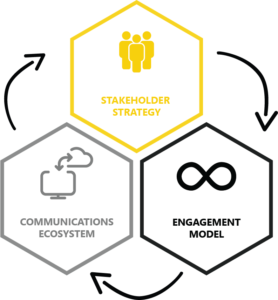The Success Gap: Part 3
The Success Gap: Part 3
Part 3 – How to Close “The Success Gap” and Achieve Your Desired Business Outcome
In this third and final part of our series I will provide a brief recap of the first two parts of the series and then discuss the steps companies can take to ensure they establish the “Appropriate Conditions for Success” necessary to close “The Success Gap” and achieve their desired business outcomes.
Series Review – What is “The Success Gap” and Why Can’t Technology Providers Help Close It?
In Part 1 we talked about what we refer to as “The Success Gap,” which is the difference between the functional requirements that the technology provides – what the technology can do – and the desired business outcome that the company wants to achieve by using the technology.
I outlined a number of what we call the “Appropriate Conditions for Success” – which are critical elements that go beyond technology functionality and are necessary to achieving your desired business outcomes.
Technology buyers often look to their technology providers to help with those “Appropriate Conditions for Success,” but as I discussed in Part 2, technology providers often struggle to effectively assist their customers with those key Conditions for Success, and I shared three observations as to why that is the case. If you haven’t already read or watched the first two Parts of the series I would encourage you to do so before proceeding with this final Part.
Close “The Success Gap” and Achieve Your Desired Business Outcome
In this final Part of the series I’m going to share some tips about how you can close “The Success Gap” and ensure that you don’t just acquire new software, but you actually achieve your desired business objectives!
The beedance Success Model
Here at beedance we’ve developed a model for closing “The Success Gap” and driving successful business outcomes – we call it “The beedance Success Model.”

The model can be applied to your engagement and communications programs with any key audience, or “stakeholder,” such as internal employees, customers and prospects, channel partners, suppliers, and even company investors, or other key stakeholder groups.
The beedance Success Model has three main components:
- Create a Digital Engagement & Communications Strategy that is Aligned to Your & Your Stakeholder’s Business Objectives
- Develop an Engagement & Communications Model that Drives Business Impact
- Ensure Your Ecosystem Supports Your Strategy
Step 1 – Create a Digital Engagement & Communications Strategy that is Aligned to Your & Your Stakeholder’s Business Objectives
This is really about setting yourself up to achieve your desired business outcome by ensuring that you and your stakeholders are pointed in the same direction and working towards common objectives.
The goals of Step 1 are to:
- Ensure alignment between stakeholder objectives and company objectives, and;
- Design a measurement model that accurately quantifies the business impact of your stakeholder engagement and communications programs.
I’d like to emphasize how important it is to develop a measurement model that quantifies business impact.
Too often we see companies “measuring success” by activity metrics (e.g., the number of webcast attendees, the number attendees who submitted a poll response, how many employees completed a digital learning course, etc.).
My response to these sorts of “success metrics” is “SO WHAT?!” Did you get the RIGHT people to attend the webcast? Did it accelerate your pipeline? Did your employees become more productive or engaged as a result of completing the training program? Do you know? How do you know?
Activity metrics are certainly an important part of an effective success model because they tell you what happened, but they alone don’t tell you what business value was created. The problem with focusing solely on activity metrics is that it often ignores whether or not those activities actually drove better business outcomes, such as accelerating pipeline, increasing order size, driving more revenue through Channel Partners, etc.
This reminds me of a quote about the nature of activity vs. outcome:
“It’s not so much how busy you are, but why you are busy.
The bee is praised, the mosquito is swatted.”
~ Mary O’Connor
Let’s get back to the two goals I outlined above – ensuring alignment with company objectives and developing a measurement model that actually quantifies business impact.
Through The beedance Success Model, we help companies achieve those goals by helping them:
- Discover the key drivers of stakeholder disengagement – before you can increase engagement it is important that you first understand why your stakeholders engage or don’t engage.
- Articulate stakeholder objectives, challenges, and perceptions – engagement is closely aligned with value creation, so understanding what motivates your audience and creates value for them is critical to driving more engagement.
- Define stakeholder communications and engagement needs and preferences – there are a multitude of different methods and channels for digital engagement – ideally you should deliver your programs in the manner most preferred by your stakeholders.
- Align company objectives with stakeholder objectives – once you have defined your stakeholder’s objectives it is critical to map those to your own business objectives so that you can design programs that drive success for both you and your audience.
- Define Engagement & Communications success metrics / tie to measures of business success – as discussed at length above, it is critical to map engagement program activity to real measures of business success.
Step 2 – Develop an Engagement & Communications Model that Drives Business Impact
Your Stakeholder Strategy should inform the development of omni-channel content and programming – what we call your Engagement & Communications Model − that is intentionally designed to drive success against your articulated business objectives.
The goal of Step 2 is to design, implement and optimize a digital content and programming model that:
- Aligns with your Stakeholder Strategy, and
- Maximizes the effectiveness and business impact of your programs.
The beedance Success Model helps companies to:
- Create a strategic approach to digital programming – for example, building an editorial calendar for programming and engagement that leverages key company milestones – for example, product launches, events, content publication, etc.
- Define the optimal mix of engagement vehicles and communications channels – this can differ widely by stakeholder group, and even with different segments or cohorts within a particular stakeholder group.
- Prepare company “personalities” for digital success – not everyone is naturally comfortable engaging digitally – we help coach executives and leaders on how to communicate most effectively through digital platforms.
- Design effective stakeholder feedback processes – this is really a process of continuous improvement. You want to design a system that continuously feeds you fresh insights to inform the design and delivery of future campaigns and engagement touch points.
Step 3 – Ensure Your Ecosystem Supports Your Strategy
It is important to analyze your Ecosystem – all the relevant technology, data and analytics systems – to ensure you have the right tools and capabilities to support your strategy and the delivery of your engagement and communications programs.
The goals of Step 3 are to:
- Maximize the use and value of your investments in existing platforms, systems and tools, and
- Ensure your Ecosystem generates the right data to measure Engagement & Communications program performance and business impact and inform continuous program improvement.
Ideally companies should look at their ecosystem last, once the strategy is defined, and then make sure they have the right capabilities to support that strategy. Of course, most companies already have technologies and systems, and so it’s often a question of how to maximize the value of existing systems while migrating to a more ideal state over time, as appropriate.
I’d like to highlight that last point with a relevant example that many companies are dealing with right now. As readers may know, Microsoft has announced the “end of life” date for Skype for Business as July 31, 2021. So, many companies are now faced with a transition to Microsoft Teams or some other set of technologies to replace Skype. beedance is helping a number of companies with this critical change management initiative as we speak.
To ensure companies have the right Ecosystem to support their strategies we:
- Conduct a thorough evaluation of your Ecosystem – this includes of all the technologies and capabilities that support the delivery of your Engagement & Communications Model – not just technology platforms, but also data sources and analytical systems.
- Identify capability gaps and define new requirements – like the above Skype example, companies should routinely reevaluate if their Ecosystem properly supports their strategy or if they need to acquire new capabilities or replace outdated ones.
- Efficiently acquire new capabilities as needed – there are a multitude of different engagement and communications technologies to support a wide range of stakeholders and program types. Companies often need support evaluating what systems best suit their needs and support for formal RFI and/or RFP processes.
Thank you to our readers and viewers for investing your valuable time with this blog series. I’ve enjoyed sharing this information with you and hope it helps you get more value out of your investments in engagement and communications technologies, close “The Success Gap,” and achieve your desired business outcomes!
Please check-out our other blog posts for more strategies, tips and advice on enhancing the value of your digital engagement and communications programs.

Categories
- Bee Wisdom (21)
- Business Intelligence (1)
- Case Studies (1)
- DE&I (1)
- Events (8)
- Experiential Marketing (2)
- Featured (3)
- Hyperlocal Events (1)
- Insights (48)
- Marketing (1)
- Pro Tips (33)



